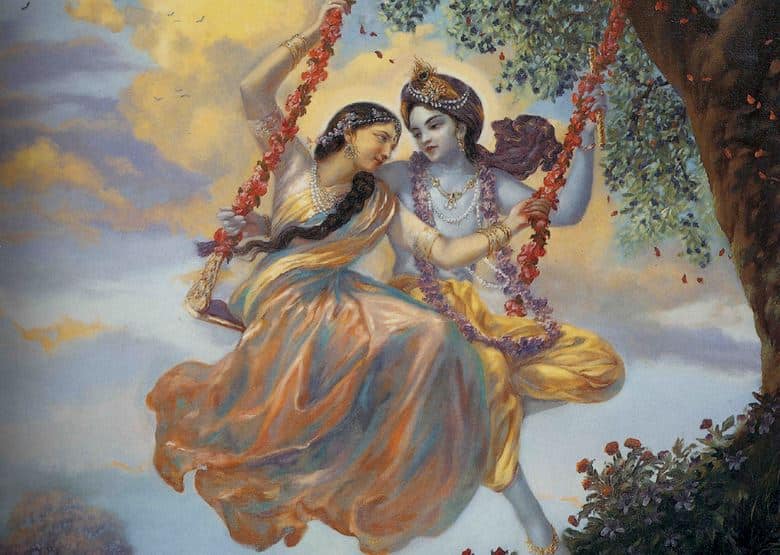Amongst the incarnations of Lord Vishnu, perhaps Lord Krishna is the most charismatic and human of all. He has his share of faults and magnetism that drew followers and haters alike. His strong sense of moral compass led to the Mahabharata war, and his distortions and interference were all to flush out the evil and retain the good.
In Duryodhana’s own words – Krishna is a “smiling rogue if there ever was one. He can eat, he can drink, he can sing, he can dance. He can make love, he can fight, he can gossip with old women, and play with little children. Who says he’s God?”
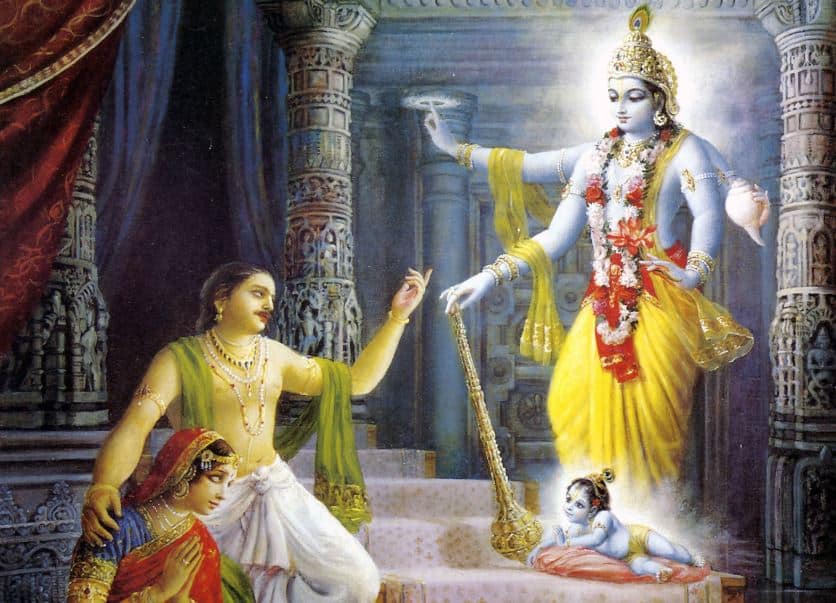
Lord Krishna and His Bal Leela
Shree Krishna and his Bal Leela are the subjects of fascination for people of all ages. Such was his divine avatar even Lord Shiva came down in the guise of a sage to get a glimpse of Lord Krishna. As a child, he had everybody wrapped around his finger.
Shri Krishna and his Birth
While the ever devoted brother Kamsa decided to imprison his newly married sister Devaki and brother-in-law Vasudev after the divine Akashvani (divine announcement) stated his end would be at the hands of the eight children of Devaki and Vasudev, the Lord had other plans. (Many scholars have now accepted the period between 3100 and 3250 BC as the period in which Lord Krishna lived on earth.)
By the time the seventh child was conceived, the gods had decided to intervene. They reached out to Goddess Yogamaya and had her transfer the fetus from the womb of Devaki to the womb of Rohini, Vasudeva’s other wife who lived far away from the prison in a village of Gokul. The child was then delivered through Rohini. He is known as Balarama.
When the eighth child was due, Kamsa got nervous. They had been under house arrest all these days, but now he shackled Vasudeva and put Devaki in a proper prison. The child was born on the eighth day into the dark half of the month, and it was pouring rain and thunder. A child was born, and a miracle happened. The prison doors opened by themselves – all the guards fell asleep – the shackles broke. Immediately, Vasudeva saw that this was divine intervention. He picked up the child and walked to the river Yamuna as if by intuitive guidance. Though the whole place was flooding, he found to his surprise that the flood which crossed the river was sticking out, and he could clearly walk.
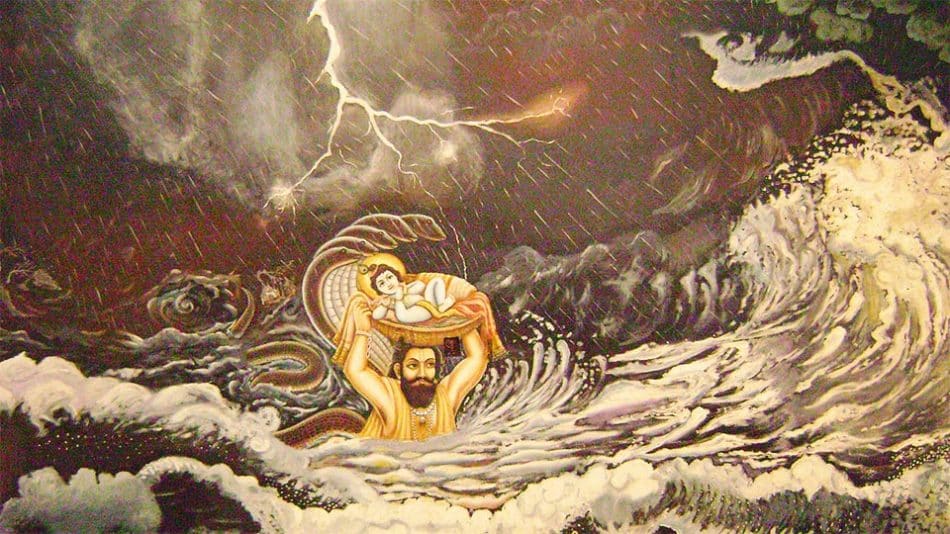
He walked across and went to the house of Nanda and his wife, Yashoda. Yashodha had just delivered a girl child. She had had a difficult labor and was unconscious. Vasudeva replaced the girl child with Krishna, took the girl child, and returned to prison. Kamsa came and saw that it was a girl. He grabbed the child by her legs and wanted to crash her on the floor. As he was about to do this, this child slipped out of his hands, flew out the window, laughed at him, and said, “Your slayer is elsewhere.” Meanwhile, Krishna was placed in the community of Gokula. Despite being the son of a chief, he grew up in an ordinary cow-herding community.
Lord Krishna and demon Putana
Kamsa enlisted a demon named Putana to kill newborn babies. The demon dressed as a beautiful woman and flew on her broom to Krishna’s nursery, hoping to kill Him with the poison she had smeared on her nipples. Krishna’s mother innocently let Putana pick the baby up and put it to her breast.
Krishna closed His eyes and sucked out her life air, killing her without taking her poison. When Putana’s soul departed, her body returned to its real form: a gigantic witch that smashed trees as it fell, stretching across the landscape. Putana’s soul attained liberation due to the benevolent act of offering her breast milk to Krishna, and the inhabitants of Vrindavana cremated the body.
Gopala – The Cowherd and Brahma
Go means “cow.” Pala means “one who tends to it.” Krishna is seen as a cowherd. He spent his childhood tending cows and calves while playing on the pasturing grounds with his friends.
When the boys got a little older, they spent their days playing with the calves in a nearby field. Their mothers cooked the noon meal and called them from the fields, or they would pack lunches for them. Children were considered the wealth of the family and were protected from abuse. However, rather than the parents protecting Krishna, the child protected the village and all the people in it.

One day the cowherd boys were playing when they came upon a mountain cave. This was actually a demon brother of Putana’s, Aghasura, who had expanded himself into an eight-mile-long snake to kill the boys. The opening to the cave was his mouth. The scriptures say that when the boys walked into the cave, Krishna became momentarily aggrieved because He knew it was one of Kamsa’s tricks.
The demigods, who had been hiding among the clouds to see what would happen, became distressed. When Krishna heard the demigods’ pleas, He grew larger and choked the demon to death. Aghasura’s life air burst through a hole in his skull and waited there for Krishna to come out; then, it merged into His body. Krishna showed His benevolent nature by rescuing His friends and giving liberation to Aghasura.
When Aghasura died, the Devi, Devtas offered prayers, threw flowers, and beat drums. Hearing the commotion, Lord Brahma arrived on the scene. At that time, Brahma kidnapped the children, an offense unbecoming of a demigod. Krishna, unable to hurt the parents, decided to expand himself into substitute boys and calves that looked exactly like the originals, and he returned to the village with them. No one could tell the difference, but families showed increased spontaneous affection for their sons.

Life went on like this for a year before Brahma returned. When he returned, he was shocked to see the boys and calves playing with Krishna as though nothing had happened. Krishna knew Brahma was perplexed, so he transformed all the boys and calves into four-armed Vishnu forms. Brahma heard music and saw many Brahmas, Shivas, demigods, and jivas (souls) singing God’s names and dancing. Brahma’s mind opened at first to the vision, but then he became bewildered, so Krishna ended the dazzling scene.
When Brahma woke up, he realized that he was face to face with Krishna, the Supreme Personality of Godhead, who was enacting His eternal pastimes as a cowherd boy in the spiritual land of Vrindavana. Brahma immediately got down from his vahana, swan, and fell prostrate at Krishna’s feet to beg forgiveness. After offering glorious prayers and penance for his behavior, Brahma circumambulated Krishna three times and returned to his planet.
Shri Krishna Lifts Govardhana Hill

Every year the residents of Vrindavana worshiped Lord Indra for supplying rain. One year when Krishna was a youth, He asked Nanda to worship Govardhana Hill instead of Indra. This made Lord Indra angry and jealous. Forgetting the divine position of Krishna, Indra felt disrespected and decided to act on his insecurities and sent a storm to devastate Vrindavana.
All the people and animals came to Krishna for shelter, and in a miraculous show of strength, Krishna lifted Govardhana Hill with one finger to make the mountain into a huge umbrella. Everyone crowded underneath it and remained safe until the rains stopped. Later, Lord Indra realized his mistake in attacking Krishna and apologized.
Shri Krishna Tames The Serpent, Kaliya
Once Krishna and his friends played by the banks of Yamuna with their ball. The ball fell into the river, where the poisonous hundred and ten-headed serpent Kaliya lived with his family. Kaliya was blinded by hatred, and his venom had started poisoning the waters of Yamuna. Krishna dove into the waters to retrieve the ball and encounter Kaliya. He ordered Kaliya to stop poisoning the water and live peacefully; blinded by rage, Kaliya refused.
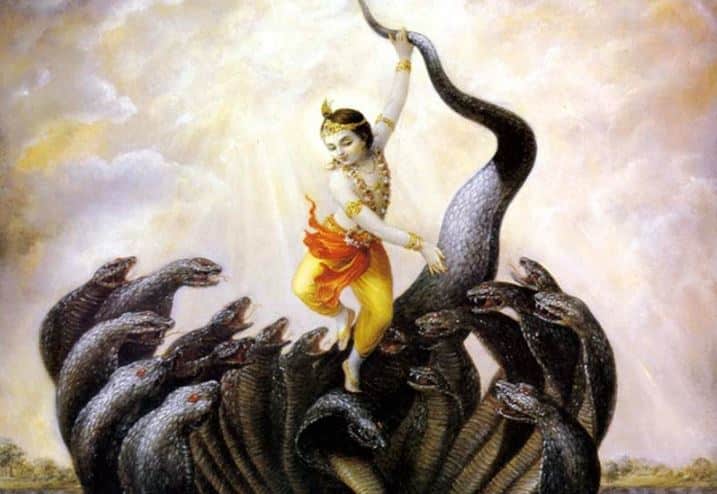
Krishna fought the giant serpent. Krishna assumed the weight of the entire universe and danced on the naga’s head, soon overpowering him. Kaliya realizing his mistakes and realizing the divine figure who rescued him from the Garuda, decided to leave Vrindavan.
Shri Krishna and Radha
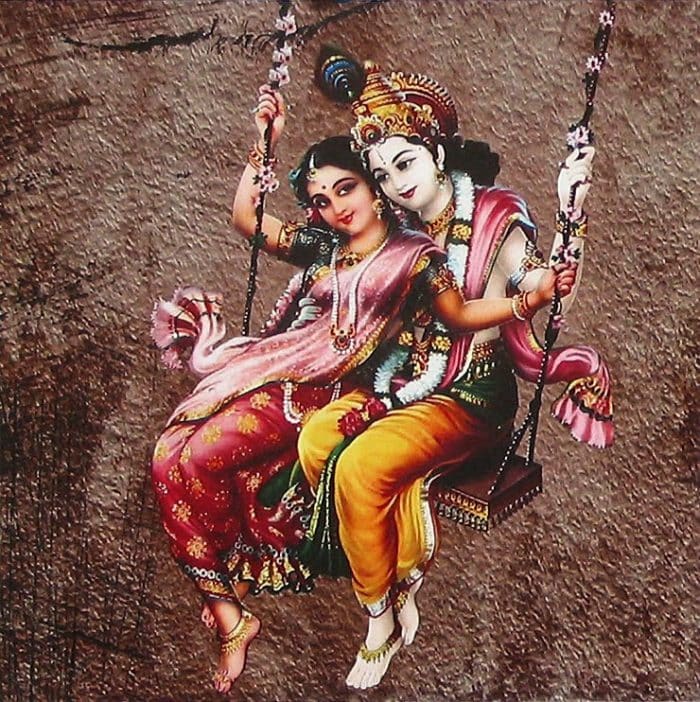
Radha was born in the village of Barsana in a simple cowherd family. She lost her mother when she was just six years old and was brought up by her maternal grandmother. When her mother was alive, she visited the Mahadeva temple in Gokula, where all the gopals and gopis worshiped Shiva. She had taken a vow to visit the temple, and after her visit, she promised she would come again. But Radha’s mother could not fulfill her vow before she died, and it was part of fulfilling this vow that Radha came with her maternal grandmother to Gokula.
Radha and Krishna met when Krishna was tied to the pounding wood by Yashoda. He just dragged it on and went towards the forest because all the cowherds, his friends, and the elders would be there in the forest. Above all, he wanted to teach his mother a lesson for being unreasonably angry.
As he was going towards the river in the forest, he passed between two big trees, and the pounding wood got stuck. He pulled it with such strength that these two trees got uprooted and crashed! But after this, he was bruised by the rope and was very tired, so he just stopped and rested there. There Radha and Krishna met for the first time.
When Radha set her eyes on 7-year-old Krishna, he never went out of her eyes. From that moment, Krishna just lived in her eyes her whole life, whether he was physically there or not there. To put it in her own words, “I live in him. He lives in me. And that’s all. It doesn’t matter where he is or who he is with; he is only with me. He cannot be anywhere else.”

And 12-year-old Radha and 7-year-old Krishna sat together, and these two beings, in many ways, merged into one in that single meeting. Nobody could put them apart after that, so much so that even after thousands of years, we still cannot think of them as two separate people. Krishna and Radha played together for a few days, and then it was time for her to leave. She was traveling in a bullock cart along with her family when they saw Krishna running behind the cart. Being such a lovable boy, they took him in the cart so that he could ride with them until the outskirts of the village. On the outskirts of the village, Krishna got down. He knew that the whole Barsana village had decided to migrate to Vrindavan, a place not yet inhabited, on the banks of the river Yamuna.
Krishna told Radha, “I will come to Vrindavan.” Radha just took this simple statement of Krishna as a promise, and she waited for months. Almost 13 months later, because of certain problems in Gokula, especially because wild animals were attacking their cattle, the people of Gokula decided to migrate to Vrindavan, a virgin forest with abundant grasslands next to the river. The whole village – men, women, children, all the livestock they had, the bullock carts and their things – everything was packed up, and they moved to Vrindavan.
A group of young and enthusiastic boys led the caravan to Vrindavan, and Krishna was the leader of this group. Radha heard that Gokul was coming to Vrindavan, and she took it as, “He is fulfilling his promise to me. He said he will come, and he is coming.”
This childhood meeting of Radha and Krishna was the beginning of a whole new spiritual path. In her love and sense of inclusion, she included him as a part of herself. They say, “There is no Krishna without Radha.” It’s not the other way around. It is not that there is no Radha without Krishna. There is no Krishna without Radha. The word “Radhe” means, Ra means Ras, which means love or juice of life. “Dhe” means “the giver.”
You must become feminine if you want to bask in Shri Krishna’s glory. This is not about being physically male or female. The feminine can be as alive in a man as it is in a woman because the feminine is a certain quality. To know Krishna, you must be willing to become feminine. This is a path to the ultimate, but it is a path of intimacy and tremendous passion. It is a path that does not exclude anything but the very nature of the path is such that once a person steps into it, everything else disappears. For Radhe, the world does not exist. Only Krishna exists. She is not a good social being but an absolutely colorful eternal being.
Shri Krishna and Raas Leela
The word “rasa” literally means “juice,” but it can also indicate passion. So Raas Leela is the dance of passion. When Krishna moved from Gokula to Vrindavan at eight years of age, he became immensely popular among the village folk. It was at the time of the Holi festival, just after spring, when everything was in full bloom.

On a certain evening, a full moon day, the boys and girls of the village gathered on the banks of the river Yamuna. They started playing and having fun throwing water and sand at each other. After some time, the play broke into a dance. And they danced and danced because they were in such an exuberant and joyful state. But slowly, one by one, the clumsier ones dropped off. When Krishna saw this, he took out his flute and started to play. His play was so enchanting that everyone gathered around him and once again swayed for almost half the night.
Krishna supernaturally stretches to the length of one night of Brahma, a Hindu unit of time lasting approximately 4.32 billion years. In the Krishna Bhakti traditions, the Raas-Leela is considered one of the highest and most esoteric of Krishna’s pastimes. In these traditions, romantic love between human beings in the material world is seen as merely a diminished, illusionary reflection of the soul’s original, ecstatic spiritual love for Krishna, God, in the spiritual world.
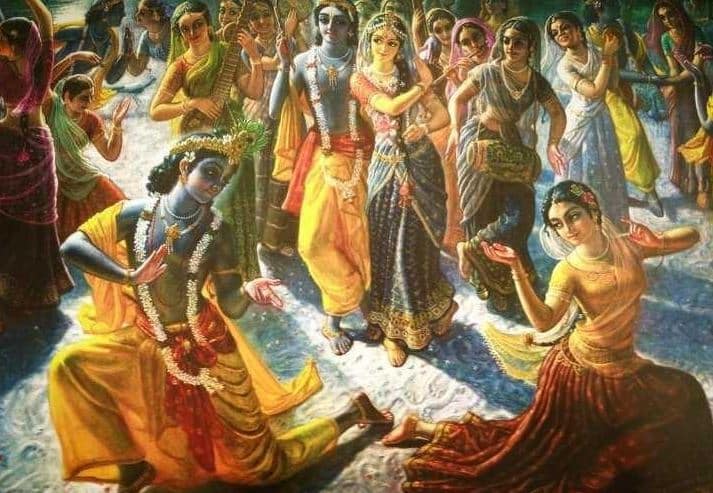
It also fell on Shiva’s ears that on full moon nights, a fantastic dance happens on the banks of the river Yamuna. He became aware that people just danced their way to what he had achieved through meditation. Shiva is Nataraja, the Lord of Dance. So being the Lord of Dance, Shiva was very amused that this little boy, his devotee, was taking people to transcendental states simply by dancing and blowing upon his flute. He wanted to witness this.
He walked from the Himalayas to the banks of the river Yamuna and said to a boatman who was there, “Please take me across to Vrindavan. I want to see Krishna’s Rasa Lila.” The boatman replied, “You cannot go like this. When you go to the Raas Leela, Krishna is the only man, and everyone else is a woman. You have to go as a woman if you want to go.”
Lord Shiva is considered the ultimate of the masculine – the Purusha among Purushas. So it was a strange request that Lord Shiva had to become a woman. But the Raas Lila was full swing, and Shiva wanted to go there. So the boatman said, “If you must go, you must wear woman’s clothing.”Such was the pull of the transcended dance that Shiva decided to wear the clothes of a gopi and went across.
Such was the power of his Raas Lila that Shri Krishna said
shravanat darshanat dhyanat mayi bhavo’nukirtanat /
na tatha sannikarshhena pratiyata tato grhan //
meaning,
“Transcendental love for Me arises by the devotional processes of hearing about Me, seeing My Deity form, meditating on Me, and faithfully chanting My glories. The same result is not achieved by mere physical proximity. So please go back to your homes”.
Jhulan Yatra
Jhulana-yatra is a festival celebrating Radha Krishna’s pastime of swinging on a golden swing every day until Balarama-Purnima. It is one of the most important festivals for the followers of Lord Krishna, celebrated in the monsoon month of Shravan. Jhulan Yatra is a swing festival observed in Shravan Month (July – August) dedicated to Lord Krishna and Lord Jagannath. After Holi and Janmashtami, it is the biggest and most popular religious occasion of the Vaishnavas.
Jhulan Yatra originates in the major Krishna legends and literature, such as the Bhagavata Purana, the Harivamsa, and the Gita Govinda.
The popular Krishna literature Hari Bhakti Vilasa (Performance of Devotion to Hari or Krishna) mentions Jhulan Yatra as part of the various festivals dedicated to Krishna.
The devotees serve the Lord during the summer by placing Him on the boat, taking Him out on a procession, applying sandalwood on His body, fanning Him with Chamara, decorating Him with jeweled necklaces, offering Him palatable foodstuffs, and bringing Him out to swing Him in the pleasant moonlight.”
In another work, Ananda Vrindavana Champu describes the swing festival as “the perfect object of meditation for those desiring a taste of devotion.”
The Jhulan Yatra of Mathura, Vrindavan, and Mayapur
Of all the sacred places in India, Mathura, Vrindavan, and Mayapur are most famous for Jhulan Yatra celebrations. The idols of Radha and Krishna are taken out from the altar and placed on heavily decked swings, sometimes made of gold and silver. Vrindavan’s Banke Bihari Temple and Radha-Ramana Temple, Mathura’s Dwarkadhish temple, and Mayapur’s ISKCON temple are some of the major places where this festival is celebrated in their greatest grandeur.



